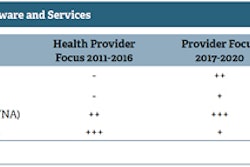NEW ORLEANS - Not all imaging informatics administrators and radiology IT staff want to keep PACS as its own silo of data in a healthcare IT enterprise data archive. Technology changes and the movement to a single integrated enterprise archive will eventually absorb it, attendees at the Healthcare Information and Management Systems Society (HIMSS) meeting were told in an educational session on Monday.
Dan O'Malley, director of informatics and support services at the University of Virginia Health System, described the hospital's attempt to move toward an enterprise medical imaging archive. The road to achieve this is not straightforward -- a fact that is not necessarily well-understood by healthcare IT professionals who aren't involved in imaging informatics.
Phases of PACS
O'Malley described three phases of PACS evolution. PACS is just beginning to emerge from its infancy, which began with DICOM image storage and has progressed to PACS images being able to be viewed from an electronic medical record. PACS is entering its adolescence as a vendor-neutral archive supporting the convergence of DICOM archives from disparate vendors. PACS' adolescence also includes the addition of non-DICOM images from other specialties, as well as the support of nonradiology/noncardiology imaging workflows.
Looking into the future, O'Malley predicts that the mature phase of PACS will reflect a unified medical imaging archive. He expects it to support sophisticated imaging analytics software, integrate patient portals, and accommodate interorganizational image exchange through health information exchanges.
There are major hurdles, however. How do you sustain these systems? How much will they cost? How will they be supported? O'Malley raised these and other questions, which will need to be addressed.
At some phase in its maturity, siloed PACS will emerge as an entity within an enterprise health IT data archive. O'Malley anticipates this will happen by the end of this decade.
He explained to the session participants, many of whom were not familiar with the origins of PACS, that the technology was the forerunner of the large data archives now taken for granted. The PACS of the 1990s consisted of proprietary systems designed to facilitate radiology department workflows. The computer hardware of the era mandated department-specific hardware to support the high performance requirements of diagnostic and even review workstations. Separate networks were needed to move images. Proprietary architecture was designed, and storage archives started with optical disk jukeboxes the size of walk-in freezers.
The only feasible way to distribute images on a PACS to other areas of a hospital, most specifically to an emergency department, was to "radiology-ize" the enterprise and force nonradiologists to conform. An example of this was the review workstation, which displayed images in a subset of the diagnostic imaging workstation format. This required users to learn complex commands that no longer exist with today's universal viewers.
Ditching the silo
"It's time to abolish imaging despotism," O'Malley said. The University of Virginia Health System is now trying to accomplish this task.
"As one of the first hospitals to implement a PACS, we were the king of imaging despotism," he said. "We were PACS-centric, and we lived in our silo. We did the best we could with the technology we had. We forced other -ologies into adopting the PACS radiology workflow."
But this required an investment in IT duplication: in hardware, dedicated IT staff, and dedicated storage, albeit storage that in recent years is archiving DICOM and non-DICOM images originating from other departments. They also had to create a tracking system to monitor data moving to and from nonradiology departments.
The radiology department quickly took all the low-hanging fruit, O'Malley said. It acquired an artificial workflow for fetal ultrasound, for radiation oncology's CTs, and for the dental department. But beyond that, efforts stagnated.
Has the department really desiloed imaging, or did it just force other departments to change their workflow to fit radiology processes? O'Malley asked. The department desiloed some areas and incorporated them into the PACS archive because it was the most robust to serve as an enterprise imaging PACS. But this has been a Band-Aid approach.
"We did a minimum enterprise integration with a hammer, forcing the other departments to adopt the radiology workflow process," he said. "Although these departments wanted to have their images available so they could be accessed by the hospital's electronic medical record, being required to adopt the radiology workflow norm was not politically acceptable."
There remains a lot of work to be done, particularly in the non-DICOM space and in terms of accommodating video images. While the hospital did make some progress in its attempt to desilo imaging, it hasn't fundamentally changed how it uses its main imaging archive, which is the PACS. But one of the positive results of the initiative is better interdepartmental collaboration.
The hospital hopes to implement a complete enterprise imaging archive that is configured to seamlessly interface with an enterprise healthcare IT data module. Challenges include funding and waiting for some technology to continue to commercially evolve at an acceptable price point.
Academic medical hospitals face the challenges of integrating an enormous amount of image data. At the University of Virginia, all images are saved. There are 60 virtual private networks to integrate and optimize. All of which make this a complicated issue.
Enterprise imaging will eventually take place, O'Malley concluded. It will become more intuitive without compromising the functionality needed by radiology, cardiology, and pathology specialties. While it's easy to talk about and understand the benefits, adoption will take time to define and clear hurdles. It is beneficial when nonradiology IT professionals are aware of these hurdles.



















